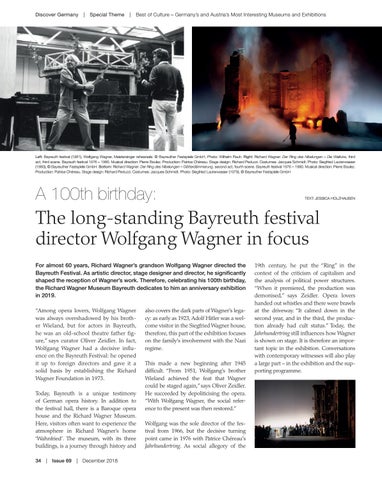Discover Germany | Special Theme | Best of Culture – Germany’s and Austria’s Most Interesting Museums and Exhibitions
Left: Bayreuth festival (1981), Wolfgang Wagner, Meistersinger rehearsals. © Bayreuther Festspiele GmbH, Photo: Wilhelm Rauh. Right: Richard Wagner: Der Ring des Nibelungen – Die Walküre, third act, third scene. Bayreuth festival 1976 – 1980. Musical direction: Pierre Boulez. Production: Patrice Chéreau. Stage design: Richard Peduzzi. Costumes: Jacques Schmidt. Photo: Siegfried Lauterwasser (1980), © Bayreuther Festspiele GmbH. Bottom: Richard Wagner: Der Ring des Nibelungen – Götterdämmerung, second act, fourth scene. Bayreuth festival 1976 – 1980. Musical direction: Pierre Boulez. Production: Patrice Chéreau. Stage design: Richard Peduzzi. Costumes: Jacques Schmidt. Photo: Siegfried Lauterwasser (1979), © Bayreuther Festspiele GmbH
A 100th birthday:
TEXT: JESSICA HOLZHAUSEN
The long-standing Bayreuth festival director Wolfgang Wagner in focus For almost 60 years, Richard Wagner’s grandson Wolfgang Wagner directed the Bayreuth Festival. As artistic director, stage designer and director, he significantly shaped the reception of Wagner’s work. Therefore, celebrating his 100th birthday, the Richard Wagner Museum Bayreuth dedicates to him an anniversary exhibition in 2019. “Among opera lovers, Wolfgang Wagner was always overshadowed by his brother Wieland, but for actors in Bayreuth, he was an old-school theatre father figure,” says curator Oliver Zeidler. In fact, Wolfgang Wagner had a decisive influence on the Bayreuth Festival: he opened it up to foreign directors and gave it a solid basis by establishing the Richard Wagner Foundation in 1973. Today, Bayreuth is a unique testimony of German opera history. In addition to the festival hall, there is a Baroque opera house and the Richard Wagner Museum. Here, visitors often want to experience the atmosphere in Richard Wagner’s home ‘Wahnfried’. The museum, with its three buildings, is a journey through history and 34 | Issue 69 | December 2018
also covers the dark parts of Wagner’s legacy: as early as 1923, Adolf Hitler was a welcome visitor in the Siegfried Wagner house, therefore, this part of the exhibition focuses on the family’s involvement with the Nazi regime. This made a new beginning after 1945 difficult. “From 1951, Wolfgang’s brother Wieland achieved the feat that Wagner could be staged again,” says Oliver Zeidler. He succeeded by depoliticising the opera. “With Wolfgang Wagner, the social reference to the present was then restored.” Wolfgang was the sole director of the festival from 1966, but the decisive turning point came in 1976 with Patrice Chéreau’s Jahrhundertring. As social allegory of the
19th century, he put the “Ring” in the context of the criticism of capitalism and the analysis of political power structures. “When it premiered, the production was demonised,” says Zeidler. Opera lovers handed out whistles and there were brawls at the driveway. “It calmed down in the second year, and in the third, the production already had cult status.” Today, the Jahrhundertring still influences how Wagner is shown on stage. It is therefore an important topic in the exhibition. Conversations with contemporary witnesses will also play a large part – in the exhibition and the supporting programme.
